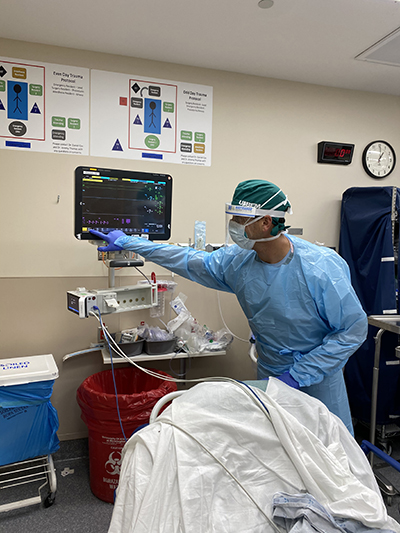 Emergency departments are crowded, and patients might want to consider alternative care options such as urgent care centers.Hospital emergency departments are pretty busy places at the best of times. During the COVID-19 pandemic, they have become busier still. Wait times are up, and space is limited at hospital emergency departments across Alabama.
Emergency departments are crowded, and patients might want to consider alternative care options such as urgent care centers.Hospital emergency departments are pretty busy places at the best of times. During the COVID-19 pandemic, they have become busier still. Wait times are up, and space is limited at hospital emergency departments across Alabama.
“We are busy,” said Andrew Edwards, M.D., interim chair of the UAB Department of Emergency Medicine. “We have patients presenting with COVID-19-like symptoms. We have patients with major emergencies such as stroke, heart attack and traumatic injury. And we have a lot of patients who come to us for a variety of conditions, some of which might be better handled at alternative care sites, which would reduce the overcrowding we see in the EDs.”
Edwards is quick to affirm that the UAB emergency departments at the main hospital, UAB Highlands Hospital and the freestanding facility at Gardendale are safe for patients who need emergency medical care.
“One unfortunate result of the coronavirus pandemic is that people are scared to go to an emergency room when they have a medical issue that requires emergency care,” Edwards said. “People experiencing heart attack, stroke or other significant health issues should not delay getting medical care for fear of contracting the virus.”
But UAB also offers several alternative care options for those conditions or illnesses that, while serious, may not require the services of an emergency department.
“We have several options that patients can use outside of the emergency room that may be appropriate for some medical issues,” Edwards said. “One is simply your primary care physician, who can now often be reached quickly through patient portals and telemedicine. Another is UAB Medicine’s Urgent Care Clinic in Southside.”
The most common medical conditions seen at UAB’s emergency departments that fall outside of the most serious issues such as stroke, heart attack and trauma include general aches and pains, arthritis symptoms, shortness of breath, headache, cough, joint or back pain, and high blood pressure. While some of these symptoms could indicate a major emergency, many could fall into the category of issues well suited to alternative care options.
“If you are not sure, by all means, go to the nearest emergency department,” Edwards said.
Options outside of the emergency room include:
- UAB Medicine Urgent Care, 125 20th St. South, Birmingham. Open 7 a.m. to 7 p.m. weekdays, 8 a.m. to 3 p.m. Saturdays, and 1 to 5 p.m. Sundays. The clinic offers access to both UAB Medicine physicians and advanced practice providers for non-life-threatening illnesses and injuries. Walk-ins are welcome, with lab and X-ray services available on-site. Wait times at Urgent Care are much lower than at the emergency departments, and co-pays can be hundreds of dollars less.
- UAB Medicine’s network of primary care physicians, with facilities in Gardendale, Leeds, Hoover, Inverness, the Kirklin Clinic and Whitaker Clinic of UAB Hospital, and UAB Family and Community Medicine at Highlands Hospital.
“Our emergency departments are open for business,” Edwards said. “But as we deal with the overcrowding and large volumes that we are experiencing now during the pandemic, we want to remember that there are other options that can be considered.”
